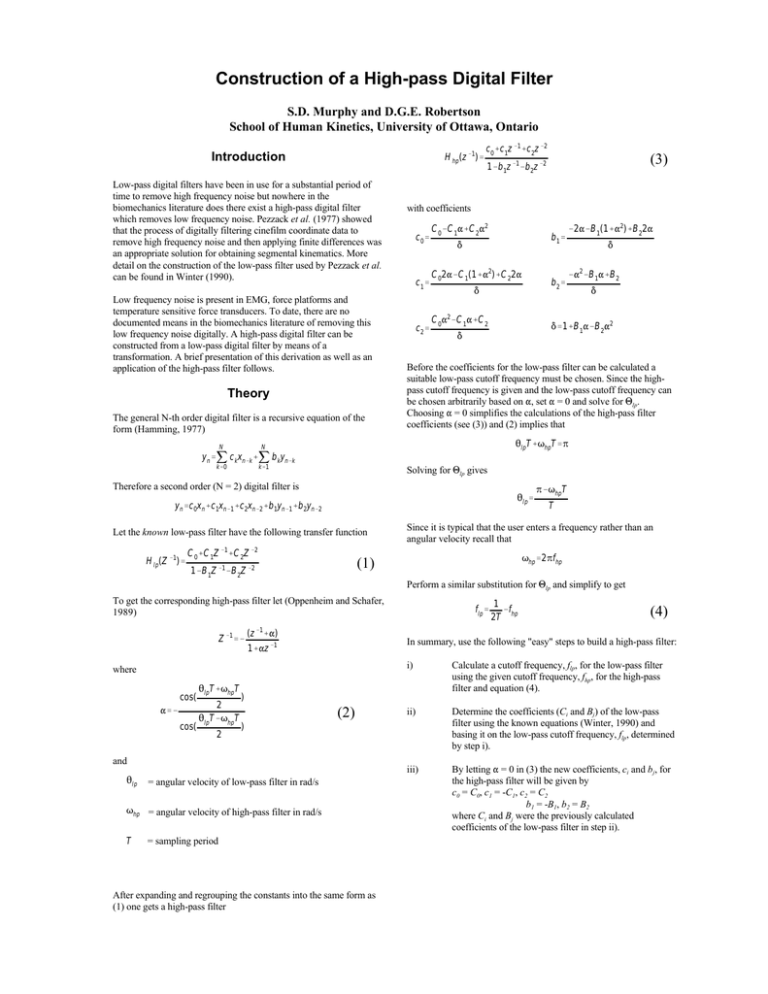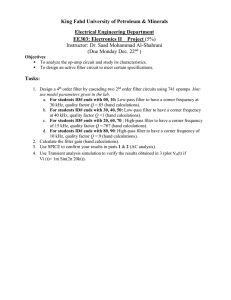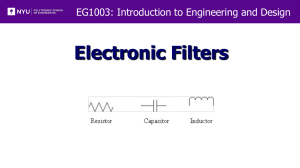Construction of a high
advertisement

Construction of a High-pass Digital Filter S.D. Murphy and D.G.E. Robertson School of Human Kinetics, University of Ottawa, Ontario H hp(z &1)' Introduction Low-pass digital filters have been in use for a substantial period of time to remove high frequency noise but nowhere in the biomechanics literature does there exist a high-pass digital filter which removes low frequency noise. Pezzack et al. (1977) showed that the process of digitally filtering cinefilm coordinate data to remove high frequency noise and then applying finite differences was an appropriate solution for obtaining segmental kinematics. More detail on the construction of the low-pass filter used by Pezzack et al. can be found in Winter (1990). Low frequency noise is present in EMG, force platforms and temperature sensitive force transducers. To date, there are no documented means in the biomechanics literature of removing this low frequency noise digitally. A high-pass digital filter can be constructed from a low-pass digital filter by means of a transformation. A brief presentation of this derivation as well as an application of the high-pass filter follows. Theory The general N-th order digital filter is a recursive equation of the form (Hamming, 1977) N k'0 k'1 with coefficients c0' c1' c2' C0&C1"%C2"2 C02"&C1(1%"2)%C22" * C0"2&C1"%C2 2 (z &1%") 1 &f 2T hp (4) i) Calculate a cutoff frequency, flp, for the low-pass filter using the given cutoff frequency, fhp, for the high-pass filter and equation (4). ii) Determine the coefficients (Ci and Bj) of the low-pass filter using the known equations (Winter, 1990) and basing it on the low-pass cutoff frequency, flp, determined by step i). iii) By letting " = 0 in (3) the new coefficients, ci and bj, for the high-pass filter will be given by c0 = C0, c1 = -C1, c2 = C2 b1 = -B1, b2 = B2 where Ci and Bj were the previously calculated coefficients of the low-pass filter in step ii). ) (2) ) = angular velocity of low-pass filter in rad/s Thp = angular velocity of high-pass filter in rad/s T flp' In summary, use the following "easy" steps to build a high-pass filter: 1%"z &1 and 2lp T Perform a similar substitution for 1lp and simplify to get where cos( B&ThpT Thp'2Bfhp To get the corresponding high-pass filter let (Oppenheim and Schafer, 1989) 2 2lpT&ThpT * Since it is typical that the user enters a frequency rather than an angular velocity recall that (1) 1&B1Z &1&B2Z &2 "'& &"2&B1"%B2 Before the coefficients for the low-pass filter can be calculated a suitable low-pass cutoff frequency must be chosen. Since the highpass cutoff frequency is given and the low-pass cutoff frequency can be chosen arbitrarily based on ", set " = 0 and solve for 1lp. Choosing " = 0 simplifies the calculations of the high-pass filter coefficients (see (3)) and (2) implies that 2lp' C0%C1Z &1%C2Z &2 2lpT%ThpT * Solving for 1lp gives Let the known low-pass filter have the following transfer function cos( b2' &2"&B1(1%"2)%B22" *'1%B1"&B2"2 * y n'c0x n%c1xn&1%c2xn&2%b1yn&1%b2yn&2 Z &1'& b1' * Therefore a second order (N = 2) digital filter is Hlp(Z &1)' (3) 1&b1z &1&b2z &2 2lpT%ThpT'B y n'j c kxn&k%j b kyn&k N c0%c1z &1%c2z &2 = sampling period After expanding and regrouping the constants into the same form as (1) one gets a high-pass filter Procedures The high-pass filter was constructed from a Butterworth, critically damped, low-pass filter as described by Winter (1990). A typical EMG signal which had drift present was high-pass filtered in the forward and backward directions (zero phase lag, 4-th order) with cutoff frequencies of 0.2 and 0.5 Hz. Results and Discussion In Figure 1, the raw EMG signal is plotted above the high-pass filtered signals with cutoff frequencies of 0.2 and 0.5 Hz. Notice that a cutoff frequency of 0.2 Hz (middle curve) removed the drift from the EMG signal. The cutoff of 0.5 Hz removed both the drift and the bias from the signal without adversely influencing the high frequency components of the signal. These results demonstrate the usefulness of a high-pass filter for removing unwanted low frequency noise from EMG signals. Figure 2 shows the results of both high and low pass filtering a signal containing 0.1, 1.0 and 10.0 Hz sine waves. The top curve is the raw data, the next curve shows the data high-pass filtered at 0.5 Hz cutoff, the third curve shows the effects of low-pass filtering at 5.0 Hz. The Figure 1 Figure 2 bottom curve shows the effects of cascading the data through a 0.5 Hz high-pass filter and a 5.0 Hz low-pass filter. This band-pass filter successfully recovered the 1.0 Hz sine wave from the raw signal. Notice that these filters do require time to reach their specified operating characteristics. In this case (zero phase lag filters) extra leading and trailing data are required (see Smith, 1989). References Hamming, R.W. (1977) Digital filters. Prentice-Hall, Inc. Oppenheim, A.V. and Schafer, R.W. (1989) Discrete-time signal processing. Pezzack, J.C. et al. (1977) J. Biomechanics, 10, 377-382. Smith, G. (1989) J. Biomechanics, 22, 967-972. Winter, D.A. (1990) Biomechanics and motor control of human movement. John Wiley & Sons. Acknowledgments For technical assistance, thanks to Dr. Tyseer Aboulnasr, Dept. Electrical Engineering, U.Ottawa. For use of data, thanks to Dr. Mario Lamontagne, School of Human Kinetics, U. Ottawa.




